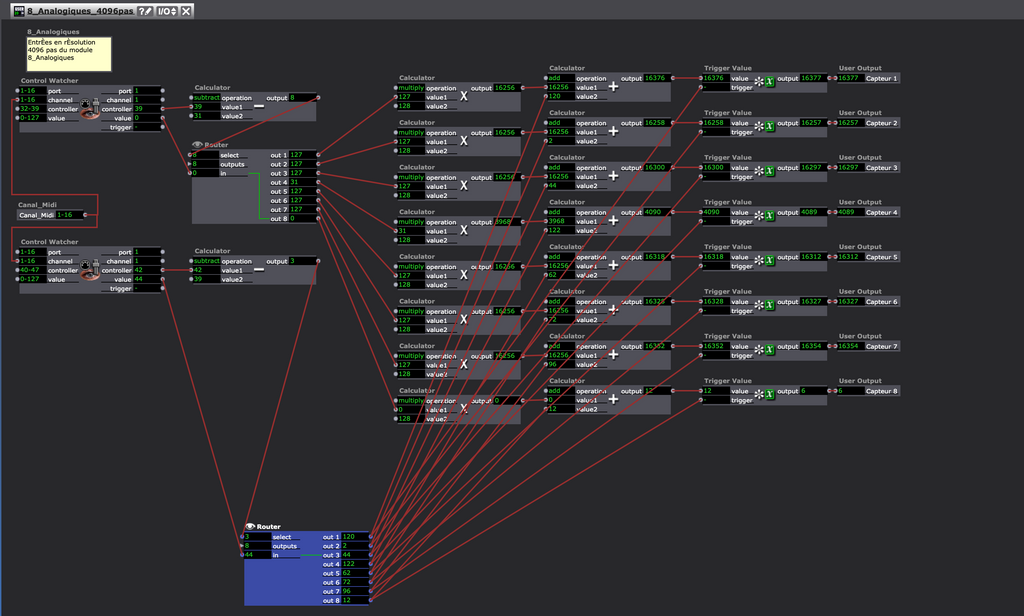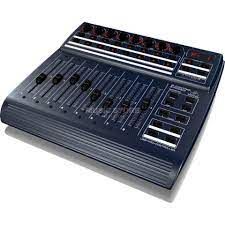OSC Hardware controllers revisited
-
@gaspar said:
https://plsn.com/featured/equi...
I have been obsessed by controllers for 20 years and I'd like to give my 2 cents, but before I have a question. Why do you need the faders to output OSC directly ? If I may speculate, it is because you probably want more than 128 steps right ? I totally get that.
I always thought that MIDI couldn't do it until I saw midi sensors interfaces built by my friends Interface Z in Paris that outputs 12 bit midi (4096 values) and for whom they made custom Isadora user actors like this one for their 8 sensor board. Don't mind the values you see in the actor in the image below. values go from 0 to 4096

I say all this because they can build cheap but sturdy custom fader boards that can output 4096 values rendering the need for OSC control surfaces less urgent.
But it is better than that. They also make dasy chainable osc sensor boards that can have 12 or 16 faders each and use 12 bits OSC. (4096 values). Also with custom made Isadora User actors.
They can buld what you want. And they are cheap !!!! For instance the 16 sensors (fader) osc board is 86.40 euros. What's not to like ?
Even better, in both the MIDI and the OSC boards, with micro switches you can decide if the board gives you 7 bits midi (0-127 values) or 12 bits (0-4096) and with an on board micro potentiometer you can customize the number of outputted values per second for the board (between 5 and 1500 values x second).
Bottom Line, the can make you for cheap what you want on 12 bits and send it to you. Fully tested. They are just great. I worked with them for 20 years. hey even make wireless sensor transmitters and receivers. Nuts.
Now, on the commercial side I love the commercial boards you all proposed but If I want to have this finesse linked to a high number of steps I also want motorized faders and none of the proposed boards are. I need motors because faders output certain values on a scene but in the next one I need them to move to a desired value so when I move them there are no sudden "jumps" in light, sound, image, etc. I used the beloved Behringer BCF 2000 for years. But it was outputting just 7 bits regular MIDI. Other drawback... a bit noisy in a theatre when you are in a quiet scene and in the next you send the motorized faders all to 0. Nothing that a piece of tape can't solve.

Behringer made a new one, the x touch. All motorized and assignable and great, Still 7 bit midi, but with a twist. Wia Ethernet it supports the HUI protocol (I think it is proprietary) but also the RTP MIDI (Real-Time Transport Protocol). That I think is hi-res and very low latency. And here I stop because it is way too technical for me although as said in the wikipedia page that seems very well done. RTP Midi seems to be compatible with the incumbent Midi 2.0 that has been cooking for a while. In fact, the MIDI Manufacturers Association has announced in January 2019 that a major evolution of MIDI protocol, called MIDI 2.0 was entering in final prototyping phase.
I hope this helps...
Cheers
-
Yes thank you. The link was on the old topic. However, both are sold out and those are "only" sliders. And as far as DYS it is a bit beyond my skills.
However I've found some mor information about the LS-Wing and it seems to do what this topic is about, and quite more actually. I found the manual here.
https://manual-hub.com/manuals...
This is what they say. Of course, this what they claim. I've not tested anything. But Lightshark is quite dedicated to the PRO segment, so I would guess it should be ok.
"Developed as a 3-in-1 product, LS-Wing can be a simple fader wing, an OSC hardware controller or a standalone MIDI console for any device that accepts MIDI control via USB. A total of four USB ports are provided, including a USB-B port, making it easy to connect to MIDI compatible devices ..."
I'm in doubt if it works also as a stand alone light console. But connected to a computer it should work. The LS-Wing has a built-in ArtNet-RDM/sACN to DMX node that offers two direct DMX universes.
The only con I see is the price tag of 980 € (if I'm mainly looking for an OSC interface).
-
Hi Armando, yes you're right. 128 steps is sometimes not smooth enough and as I am out to buying something new... I had a look around.
Interface Z does look great. Do they also offer the complete hardware (I mean a console with motorised sliders and a few knobs)?
On their page I just found the electronics, which is great but I'm in need of some more.And yes the Beringher BCF 2000 is a classic one. I had an eye on it and as you say, there are the newer X touch consoles. There is also the ICON platform M+, both belong to my favourite options.
A somewhat different option but quite interesting too are these consoles from ZOOM: R16, R29, R24. This way you could have an audio interface allowing you to have several inputs and outputs to lay with inside ISADORA in addition to a physical interface with sliders and buttons. Unfortunately, I don't think those are motorised but still very interesting.
Cheers
-
Hello,
I own the X-Touch compact and I can give you some infos.
— there is 2 modes : MCU (Mackie Control Unit) with 10 bits precision for the faders and Standard Midi with 7 bits precision.
— I am doing a device in TD allowing to use of motorized fader using standard midi, but thats with only 7 bits faders :-(
— I am trying to build a MCU receiver/sender in TD but that's not so easy. You need a constant ping and analyze sysex but that's a good summer job…
— The big brother X-Touch doesn't have standard midi mode, only MCU !
Jacques
-
I just wanted to add a little, a bit dissapointing, update. The LS-Wing, which for all I could read is really a great device, does NOT have motorised faders.
-
Thank you for the info. Just one question. How do you read in the 10bits from MCU mode, when connecting the X-Touch to Isadora?
Thanks
-
With Pitch Bend Watcher, you receive the fader position (0 - 16384)
With Send Pitch Bend, you can assign fader position (O-16384)
Fader 1 - Channel 1 etc.
-
@jhoepffner Thanks Jacques for your always precious inputs. Let me understand. You are telling us that in Mackie Mode the xtouch (not the big on3 with the big wheel) each fader and rotary encoders send pitch bend and not control change?
-
@gaspar That is why I asked. In my opinion without motorized faders everything is more complicated. The interface seems great in everything... but for that.
-
Hello Armando, I just tested yesterday with Isadora and with Mackie Mode you receive pitch bend and if you send pitchbend you move fader and encoder leds. (approx 9 bits)
Unfortunately, in Mackie mode, the surface is not using encoder 9 to 16 :-(
So the choice is:
– MCU with more or less 9 bits but only 9 faders and 8 encoders
- standard midi with 7 bits but 9 faders and 16 encoders
I am building a device for TD and I am still hesitating…
Also layer A-B its not usable in standard midi because when you are in layer A, layer B is not impacted and when you change layer the new values are not sent.
-
@jhoepffner before you do all the hard work take a look at this:
https://github.com/NicoG60/OscMackieControl/blob/master/HUI%20Mackie%20Control.touchoscthere is also a stand alone python implementation (that might me adaptable to Isadora via JavaScript actors) https://github.com/matthewmx86/mackie-hui-osc
-
Thank you Fred, I know this project but I am building a proper TD object, without the need of OSC.
-
Thank you for the info about Pitch Bending being sent.
I'm finally getting the XTC. Since the LS-Wing is not motorised. I went for the XTC because of the layout. The Icon Platform M+ layout would make it difficult to use flash buttons (lighting console) without interfering with the sliders.
In the meantime, I wrote a tiny patch that:
1. Smoothes my NanoKorg output (coming from Dx NanoKontrol 2 actor) - Then I can scale it in the receiving actor. Obviously, the amount of attainable final values won't exceed 127, but on the way there you get all the values in between. Actually, I'm not sure I will notice the increase in smoothness. Have not tried it other than on screen.
2. In order to prevent value jumps when values have changed without using the hardware interface. The data coming from the interface are only output once they "cross" the actual value in Isadora.
If pages/layers don't work on the controller side, it should be possible to make as many pages/layers as you need directly inside ISADORA (or TD), by storing the actual layout values before changing to a different page and recall them when coming back. Of course it would be nice not having to do that, but it should be possible.
-
Ciao Jacques,
You are telking about the big xtouch isn't it ? I don't understand well your post, sorry. Doeis it means that in Mackie mode 8 faders only are sending pitch bend in isadora but all of the rotary potentiometer works ? Also with pitch bend ? And buttons still send 0/127 in normal midi mode ?
Thanks Jacques
-
I think @jhoepffner is referring to the XT Compact, since above he states he ownes that one. As for the rest, I have no idea and guess I'll see it Once I have the device.
-
As Gaspard says, I talk about the X-Touch Compact (there is no standard midi with the big X-Touch :-(
In Mackie mode:
— 9 faders send (reduced) pitch bend, CC value 0-1 when you touch the fader
— 8 encoders (top side ones) send CC value : 0 for clockwise rotation, 64 for anti-clockwise rotation and 0-1 (on different CC) when you push it
— 8 encoders (right side, 9 to 16) are not transmitted, the push function is transmitted (CC 0-1)
-
Finaly, I will use the Standard Midi mode for my tool, the gain in precision for the faders are not so great in reality, the encoder behaviour not so easy to manage and the lack of eight knob a big lost. I will inform you when ready. I will add OSC in/out so you can use it beside Isadora with the non-commercial version of TD.
-
@jhoepffner said:
e gain in precision for the faders are not so great in reality, the encoder behaviour not so easy to manage and the lack of eight knob a big lost. I will inform you when ready. I will add OSC in/out so you can use it beside Isadora with the non-commercial version of TD.
Probably a wise choice and thanks for keeping us up to date.
Yes 127 values is clearly lower than what can be achieved, but it is still enough for almost anything you might want to do with it.
However, I was actually wondering why there is no new interface in the market since 2019. Most of the ones being from 2014 or older.Good luck
-
@gaspar @jhoepfner Thanks Jacques for the explanation. And gaspar for the questions. In fact it is amystery to me that there are NO control surfaces outputting OSC and that have motorized faders. A real hole in the market.